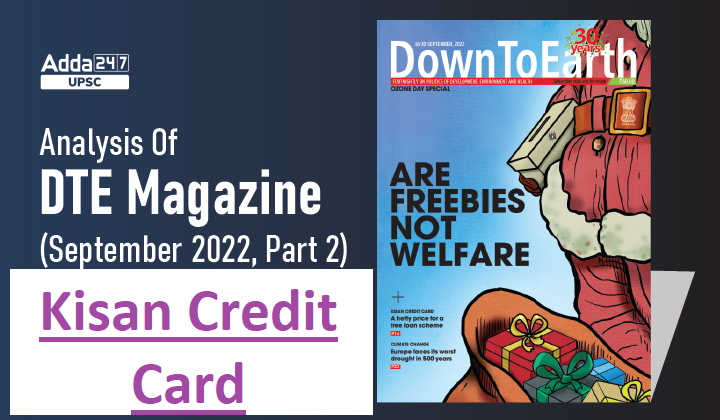Table of Contents
Introduction
- IN 1998, the National Democratic Alliance government launched Kisan Credit Card (KCC) to help farmers get access to institutional credit.
- As of 2022, there are over 73 million operational KCC cards, as per a reply given by the Union Minister of State for Finance in the Lok Sabha on April 4, 2022.
What is KCC?
- As per Reserve Bank of India’s (RBI’s) 2019 “Report of the Internal Working Group to Review Agricultural Credit”, the card aims at “providing adequate and timely credit support from the banking system under a single window” for farmers’ “overall credit requirements such as cultivation of crops, post harvest expenses, marketing of produce, maintenance of farm assets, activities allied to agriculture and also consumption requirements of farmer households”.
Who is eligible for KCC?
- KCCs cover all category of farmers, but are particularly helpful to those who are categorised as marginal and small (with landholdings up to 2 hectares) and constitute over 86 per cent of India’s farmers, as per Agriculture Census 2015-16.
- KCC is issued for a term of five years and can be renewed. Farmers and farming collectives, such as land owner cultivators, tenant farmers, oral lessee, agricultural labourers and self help groups, are eligible for KCC.
What are the key advantages of KCC?
- The KCC credit limit/ loan amount is fixed by banks as per guidelines prescribed in RBI’s Master Circular dated July 4, 2018.
- As a concept, KCC works like any credit card, but has several advantages.
- The rate of interest in case of default in repayment is just 7 per cent against the common credit cards, where the figure can exceed 20 per cent.
- Moreover, timely payment of dues attracts a government subsidy of 3 per cent, so the effective rate of interest amounts to 4 per cent.
- The KCC credit cycle is also of six months against the usual monthly cycle of the average credit card. The process of getting KCC can last about a month.
What is the procedure to avail KCC?
- An applicant has to approach the bank for the card and has to produce the record of land ownership, tenancy or a witness in case the applicant is an oral lessee.
- Bank verifies the documents and inspects the land to decide the card limit (loan limit) on the applicant’s profile and risk assessment.
- KCC also does not have an upper limit. Loans taken by big farmers can run into crores of rupees.
- Farmers cannot get the entire credit limit in the first year itself. The limit rises by 10 per cent every year to reach the maximum amount in the fifth year.
What are the loopholes?
- In practice, landless farmers rarely get KCC.
- RBI’s 2019 report quotes National Bank for Agriculture and Rural Development’s “All India Rural Financial Inclusion Survey 2016-17″ to say that “in the absence of a proper legal framework and lack of records relating to their agricultural activity, tenant farmers/ share croppers/ oral lessees/ landless labourers face difficulty in accessing institutional credit”.
- RBI has also asked banks to provide a magnetic strip KCC to farmers, as per its Master Circular of 2018.
- As per State Bank of India, only about 60 per cent of its KCC holders have been given magnetic strip credit cards. Most get the money in their KCC accounts and a cheque from the bank for the loan



 TSPSC Group 1 Question Paper 2024, Downl...
TSPSC Group 1 Question Paper 2024, Downl...
 TSPSC Group 1 Answer key 2024 Out, Downl...
TSPSC Group 1 Answer key 2024 Out, Downl...
 UPSC Prelims 2024 Question Paper, Downlo...
UPSC Prelims 2024 Question Paper, Downlo...





